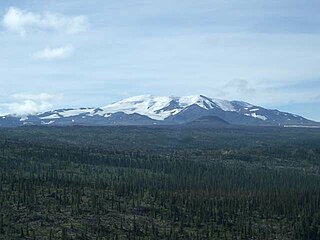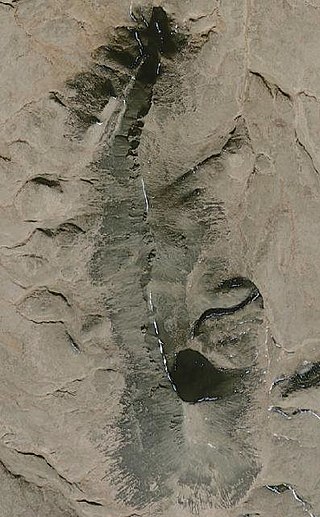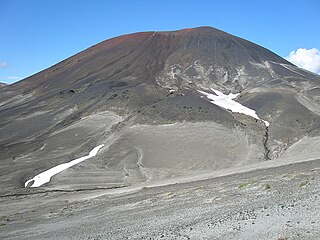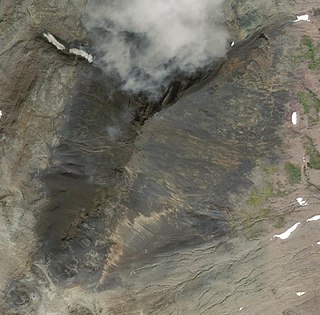Related Research Articles

The Northern Cordilleran Volcanic Province (NCVP), formerly known as the Stikine Volcanic Belt, is a geologic province defined by the occurrence of Miocene to Holocene volcanoes in the Pacific Northwest of North America. This belt of volcanoes extends roughly north-northwest from northwestern British Columbia and the Alaska Panhandle through Yukon to the Southeast Fairbanks Census Area of far eastern Alaska, in a corridor hundreds of kilometres wide. It is the most recently defined volcanic province in the Western Cordillera. It has formed due to extensional cracking of the North American continent—similar to other on-land extensional volcanic zones, including the Basin and Range Province and the East African Rift. Although taking its name from the Western Cordillera, this term is a geologic grouping rather than a geographic one. The southmost part of the NCVP has more, and larger, volcanoes than does the rest of the NCVP; further north it is less clearly delineated, describing a large arch that sways westward through central Yukon.
Tuya Butte is a tuya in the Tuya Range of north-central British Columbia, Canada. It is a bit less isolated from other ranges than neighbouring Mount Josephine. Some of the other volcanoes in the area include South Tuya, Ash Mountain, and Mathews Tuya.
Williams Cone is a satellite cone of Mount Edziza, located 36 km (22 mi) east of Telegraph Creek. It lies just off the northern edge of the Tencho Icefield and is one of the many postglacial cinder cones that lie on the Mount Edziza volcanic complex. Williams Cone last erupted about 1,350 years ago along with other nearby volcanoes, such as the well-preserved Eve Cone.
The Pyramid, also called Pyramid Dome, is a young lava dome on the northeast flank of Mount Edziza in British Columbia, Canada. It represents several different styles of volcanic activity of the Mount Edziza volcanic complex, part of the Northern Cordilleran Volcanic Province. Its latest eruption occurred during the Pleistocene epoch.
Coffee Crater is a well-preserved cinder cone south of Mount Edziza, British Columbia, Canada. It was formed during the Holocene period. It is within the Snowshoe lava field, part of the Mount Edziza volcanic complex.
Sidas Cone is a cinder cone on the Big Raven Plateau at the northern end of Mount Edziza Provincial Park in British Columbia, Canada. Its name, meaning "cut oneself with a knife" in the Tahltan language, is descriptive of the breach that has cut the cone into two symmetrical halves.

Tsekone Ridge, also called Tsekone Peak and Black Knight Cone, is an isolated ridge on the Big Raven Plateau of the Tahltan Highland in northwestern British Columbia, Canada. It is located southeast of Telegraph Creek at the north side of Mount Edziza Provincial Park between Eve Cone and Mount Edziza.

Cocoa Crater is a cinder cone in the Stikine Country of northwestern British Columbia, Canada. It is located 38 km southeast of Telegraph Creek and 8 m (26 ft) southwest of Mount Edziza. Cocoa Crater is one of the 30 cinder cones around the Mount Edziza complex that formed in the year 700. The ash around Cocoa Crater is quite deep, its summit is a jet black color and its summit is red. It is quite a different color from the brown color of Coffee Crater, which is to the south of Cocoa Crater.
Castle Rock is a volcanic plug located 13 km (8 mi) west of Iskut and 8 km (5 mi) northwest of Tuktsayda Mountain in British Columbia, Canada. Castle Rock is part of the Pacific Ring of Fire that includes over 160 active volcanoes and is in the Klastline Group of the Northern Cordilleran Volcanic Province and last erupted in the Pleistocene.

Wetalth Ridge is an isolated ridge in northern British Columbia, Canada, located 74 km (46 mi) southwest of Tatogga and south of Telegraph Creek. It lies on the southwest side of Little Arctic Lake at the southwest corner of Mount Edziza Provincial Park.
Pillow Ridge is a ridge of the Tahltan Highland in northern British Columbia, Canada, located southeast of Telegraph Creek. It extends northwest from Mount Edziza in Mount Edziza Provincial Park.
The Triplex Cones are a group of three cinder cones in northern British Columbia, Canada. They are thought to have last erupted during the Holocene epoch.
Cartoona Peak is a volcanic peak at the westernmost end of Cartoona Ridge in northern British Columbia, Canada, located just southeast of Coffee Crater in Mount Edziza Provincial Park.
IGC Centre is a lava dome in Mount Edziza Provincial Park of northern British Columbia, Canada. It is thought to have formed and last erupted during the Miocene period.
The Neck is a mountain in northwestern British Columbia, Canada, located in Mount Edziza Provincial Park. It is a volcanic feature of the Northern Cordilleran Volcanic Province that formed in the past 1.6 million years of the Pleistocene epoch.
Exile Hill is an isolated hill in the Spectrum Range of northern British Columbia, Canada, located southeast of Mess Lake. It lies at the southern end of Mount Edziza Provincial Park.
Tadekho Hill is an isolated hill in the Northern Interior of British Columbia, Canada, located 64 km (40 mi) southwest of Tatogga and 10 km (6 mi) southwest of Kitsu Peak. It lies at the southwestern end of Mount Edziza Provincial Park.

The Volcano, also known as Lava Fork volcano, is a small cinder cone in the Boundary Ranges of the Coast Mountains in northwestern British Columbia, Canada. It is located approximately 60 km (40 mi) northwest of the small community of Stewart near the head of Lava Fork. With a summit elevation of 1,656 m (5,433 ft) and a topographic prominence of 311 m (1,020 ft), it rises above the surrounding rugged landscape on a remote mountain ridge that represents the northern flank of a glaciated U-shaped valley.

The volcanic history of the Northern Cordilleran Volcanic Province presents a record of volcanic activity in northwestern British Columbia, central Yukon and the U.S. state of easternmost Alaska. The volcanic activity lies in the northern part of the Western Cordillera of the Pacific Northwest region of North America. Extensional cracking of the North American Plate in this part of North America has existed for millions of years. Continuation of this continental rifting has fed scores of volcanoes throughout the Northern Cordilleran Volcanic Province over at least the past 20 million years and occasionally continued into geologically recent times.
References
- ↑ "Crow Lagoon". Global Volcanism Program . Smithsonian Institution . Retrieved 2018-03-14.
- ↑ Volcanoes of Canada Archived August 10, 2007, at the Wayback Machine Retrieved on 2007-10-10